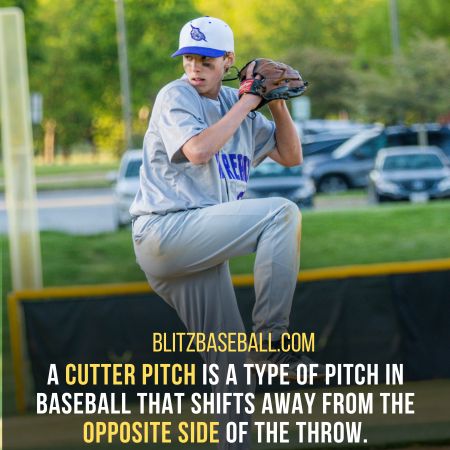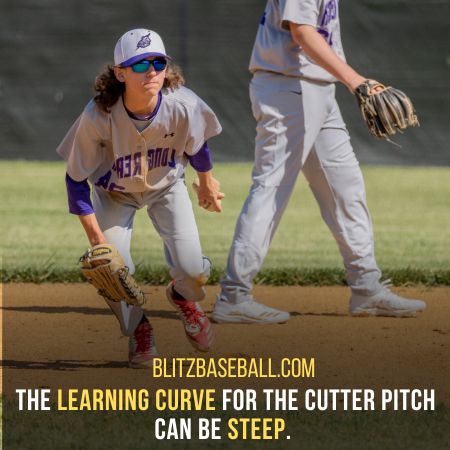Are you a baseball lover? Then you might wonder what is a cutter pitch exactly. The cutter pitch is a type of pitch commonly used in baseball, favored by professional pitchers due to its ability to shift away from the opposite side of the throw.
This pitch is executed with a sharp, cutting motion and high velocity, aiming to induce ground outs by preventing the barrel of the bat from aligning with the breaking ball.
The benefits of the cutter pitch include late break or divergence at home plate, making it challenging for hitters to achieve solid contact and even causing bats to shatter. It is especially effective against batters of opposite handedness, and its mastery necessitates extensive practice.
The technique involves holding the middle and index fingers tightly over the seams, placing the ring finger on the seams, and positioning the thumb beneath. The arm action should resemble that of a fastball, while the grip applies pressure to the ball’s outer edge, resulting in a faster movement akin to a slider.
Achieving proficiency in the cutter pitch requires meticulous practice, diligent arm care, and precise finger adjustment.
Key Takeaways
- A cutter pitch is a type of pitch that shifts away from the opposite side of the throw and is thrown at high velocity with a sharp, cutting motion.
- The benefits of a cutter pitch include late break or divergence at home plate, difficulty for hitters to make solid contact, and the ability to shatter bats.
- The cutter grip technique involves holding the ball tightly with the middle and index fingers over the seams, placing the ring finger on the seams, and positioning the thumb beneath.
- The cutter pitch differs from a slider and a cut fastball in terms of break, shape, and movement, and it is a variation of the fastball that moves slightly to the side upon reaching the plate.
What is a Cutter Pitch?
A cutter pitch is a type of pitch in baseball that shifts away from the opposite side of the throw. It is thrown at high velocity with a sharp, cutting motion. This pitch is preferred by some big league pitchers with the aim of making the hitter hit a ground out.
The cutter pitch offers several advantages. One advantage is its late break or divergence at home plate, making it difficult for hitters to make solid contact. Another advantage is that it can even shatter bats. It is particularly effective against batters of opposite handedness.
However, mastering the cutter pitch requires hours of practice to perfect. This is due to its unique grip technique and consistent arm action for deceptive movement. The learning curve for the cutter pitch can be steep. But with proper practice and dedication, pitchers can harness its potential for success on the mound.

Benefits and Technique
Late break or divergence at home plate is one of the advantages of using the cutter pitch, making it difficult for hitters to make solid contact. This pitch is thrown at high velocity with a sharp, cutting motion, and it is preferred by some big league pitchers.
The cutter grip technique involves holding the ball with the middle and index fingers tightly over the seams, with the ring finger placed on the seams and the thumb positioned beneath. Consistent arm action is required for deceptive movement, and the grip adds pressure to the ball’s outer edge.
Mastering the cutter pitch requires hours of practice, proper arm care, and finger adjustment. It is a variation of the fastball that moves slightly to the side upon reaching the plate, keeping the ball out of the batter’s reach.
Difference from Slider and Fastball
The difference between a slider and a cut fastball lies in the size and shape of the break, with the slider having a bigger break and a different shape.
The grip and mechanics of a cutter pitch involve holding the ball with the middle and index fingers tightly over the seams, the ring finger on the seams, and the thumb positioned beneath. The aim is to create consistent arm action for deceptive movement by adding pressure to the ball’s outer edge.
The cutter pitch is known for its effectiveness against left-handed hitters. It moves slightly to the side upon reaching the plate, keeping the ball out of the batter’s reach. This late movement towards the glove side makes it difficult for left-handed hitters to make solid contact, resulting in groundouts or weakly hit balls.
Pitching for Right-Handed Pitchers
For right-handed pitchers, mastering the grip and mechanics of the cutter pitch can be challenging, especially for those with low arm angles. However, with proper practice and finger adjustments, they can effectively produce late movement towards the glove side. This pitch can be a valuable weapon in a right-handed pitcher’s arsenal.

Here are three key points to consider:
-
Low arm angle pitchers: Pitchers with a low arm angle may find it more difficult to master the cutter pitch due to the different arm path required. It may take extra effort and practice to develop the necessary consistency and control.
-
Mariano Rivera’s cutter effectiveness: One of the most notable pitchers known for his cutter pitch is Mariano Rivera. His cutter was extremely effective, breaking late and sharply towards the glove side. Rivera’s mastery of the pitch allowed him to dominate hitters and become one of the greatest closers in baseball history.
-
Late movement towards the glove side: The cutter pitch, when executed correctly, can deceive hitters with its late movement. It moves slightly to the side upon reaching the plate, keeping the ball out of the batter’s reach. This late movement towards the glove side makes it particularly effective against opposite-handed batters.
Frequently Asked Questions
How can I improve my cutter pitch velocity?
To improve cutter pitch velocity, pitchers can focus on several tips and techniques. These include strengthening the arm, improving mechanics, and maximizing power generation through proper body positioning and timing. Adding movement to the cutter pitch can be achieved by adjusting finger pressure and grip, as well as fine-tuning the release point for optimal results.
Can a cutter pitch be thrown as a strikeout pitch?
Yes, a cutter pitch can be thrown as a strikeout pitch. The effective grips for a cutter pitch include holding the ball tightly over the seams with the middle and index fingers, while placing the ring finger on the seams and the thumb beneath. The role of deception in throwing a cutter pitch involves consistent arm action for deceptive movement and adding pressure to the ball’s outer edge with the grip.
What are some common mistakes to avoid when throwing a cutter pitch?
Common mistakes to avoid when throwing a cutter pitch include improper grip technique, inconsistent arm action, snapping the wrist, and not applying enough pressure to the ball’s outer edge. Proper practice and attention to detail are necessary for mastery of this pitch.
Are there any specific drills or exercises to help master the cutter grip technique?
To master the cutter grip technique and perfect the cutter release, pitchers can engage in specific drills and exercises. These may include finger strengthening exercises, working on consistent arm action, and practicing the grip with various throwing motions to develop muscle memory and control.
How does the movement of a cutter pitch change depending on the pitcher’s arm angle?
The movement of a cutter pitch can be influenced by the pitcher’s arm angle. Different arm angles can result in variations in the direction and break of the pitch, affecting its movement towards the glove side.

Conclusion
In conclusion, the cutter pitch is a highly effective pitch in baseball that offers several benefits to pitchers. Its ability to shift away from opposite-handed hitters and its late break at home plate make it difficult for batters to make solid contact.
The grip technique, arm action, and finger adjustment required to throw a cutter pitch properly take hours of practice to perfect. It is important for pitchers to prioritize arm care to avoid injury while mastering this pitch.
Overall, the cutter pitch is a valuable weapon in a pitcher’s arsenal.
